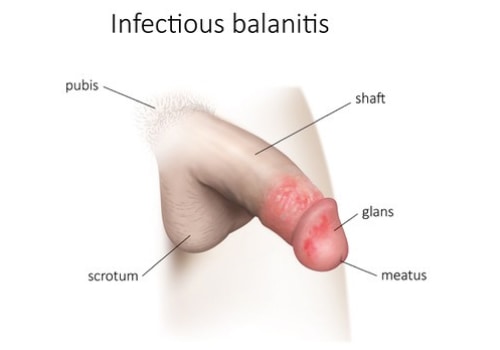What is Balanitis?
The term balanitis comes from the Greek and indicates an infection or inflammation of the skin of the top of the penis (glans) that manifests itself through the appearance of one or more of the following symptoms:
-
REDNESS ON THE GLANS AND INSIDE THE FORESKIN,
- LOSSES
- BAD SMELL,
- ITCHING (RARELY)
Balanitis can affect both circumcised men and the remaining population, although with greater frequency in the latter due to a more difficult intimate hygiene, essential to remove the smegma that can accumulate under the foreskin favouring the appearance of these annoying infections.
Finally, we speak of balanoposthitis when the inflammation also involves the inside of the skin of the foreskin (the foreskin is the skin envelope of the glans, which is removed in circumcised subjects).
Candida balanitis
In humans, they occur at the genital level as rashes, often painful and covered with a slight whitish secretion. Candida infections are caused by Candida Albicans yeast, and balanitis/balanoposthitis is no exception; it is a microorganism in all healthy individuals. However, when it takes over and manages to increase uncontrollably, it can become responsible for the infection.
If not treated, they can become the cause of complications such as phimosis.
Unlike what is thought, sexual transmission is only one of the possible causes of contagion and not even the most frequent.

Balanitis is caused by inflammation or infection that occurs at the level of the glans, often due to poor intimate hygiene or because it is not possible to find out by sliding the foreskin towards the base of the shaft of the penis (due to phimosis, a very common eventuality in children and up to adolescence).
When the penis is not washed correctly, even under the foreskin, smegma can accumulate, a whitish substance characterised by an unpleasant odour, which irritates the mucous membrane of the penis, favouring the appearance of inflammation.
INFECTIONS WITH FUNGI (CANDIDA) OR BACTERIA THAT LIVE ON THE SKIN (IT CAN OCCUR, FOR EXAMPLE, IN CASE OF DIABETES, TAKING ANTIBIOTICS OR SIMPLY IN CASE OF POOR HYGIENE),
SEXUALLY TRANSMITTED INFECTIONS, SUCH AS GENITAL HERPES, GONORRHEA AND SYPHILIS,
SKIN IRRITATION CAUSED BY AGGRESSIVE DETERGENTS (CONTACT DERMATITIS),
BENIGN SKIN DISEASES, SUCH AS PSORIASIS, ATOPIC ECZEMA, LICHEN,
SOME TYPES OF SKIN CANCER (ARE VERY RARE).
In young boys, it can eventually occur due to excessive manipulation of the foreskin.
In theory, all men can get sick, but the disorder occurs more frequently in those with a tight foreskin, which is challenging to pull back, and among those who do not pay enough attention to intimate hygiene.
Diabetes is a known risk factor for all kinds of infections, especially if you can not control your blood sugar well; in case of too high values (hyperglycemia), there is an increase in the sugars present in the urine which, coming into contact with the glans and foreskin, tends to favour the proliferation of yeasts and bacteria.
If the disorder is recurrent, it can be caused by a yeast infection (candida) transmitted and retransmitted between partners during intercourse (ping-pong effect).
Circumcised men are less prone to the development of balanitis because they have a condition that is easier to manage hygienically. The absence of foreskin does not allow the stagnation of tiny drops of urine at the end of urination.
Typical symptoms of balanitis include:
- REDDISH AND INFLAMED RASH ON THE PENIS OR UNDER THE FORESKIN,
- SWELLING
- ITCHING OR BURNING IN THE AFFECTED AREA,
- PAIN AND BURNING WHEN URINATING,
- WHITISH, LUMPY OR YELLOWISH LEAKAGE FROM THE AFFECTED SKIN OR FORESKIN.
- DANGERS
Neglected balanitis, or recurrent episodes, can favour the appearance of phimosis, a disorder that causes the narrowing of the foreskin, preventing its regular sliding on the glans; in severe cases, it is a condition that requires minor surgery to be resolved.
Most cases of balanitis react to therapy within 3-5 days (which should be continued for the entire duration indicated by the doctor).
When to contact your doctor
Balanitis is not a severe problem, but it is essential not to neglect it. It is recommended for this to turn to the caregiver in case of doubtful symptoms immediately.
It is essential to check, for example, the possible co-presence of sexually transmitted and candida infections and exclude possible (rare) more severe causes.
It is then necessary to report whether:
- THE CURE SHOWS NO IMPROVEMENT AFTER A FEW DAYS,
- FREQUENT RECURRENCES OCCUR.
In the case of diabetes, the appearance of numerous episodes at close range may indicate a non-optimal control of blood sugar.

Your doctor can usually recognise and diagnose balanitis with a simple visual examination. Still, in some cases, it may be necessary to take a swab or a skin sample to be examined under a microscope or sent to the laboratory for further examination to confirm the diagnosis.
Equally valuable is reconstructing the patient's anamnesis, considering any further examinations (looking for sexually transmitted diseases, for example) or providing information on the methods of proper intimate hygiene and the products used.
If the infection does not respond to therapy or has characteristics different from a typical condition, your doctor may advise you to visit a dermatologist (skin disease specialist).
The type of therapy depends on the cause of the disorder. Still, it cannot be separated from the practice and regular proper intimate hygiene, which includes the daily washing of the penis, discovered by the foreskin, with warm water and possibly specific (or delicate) detergents.
In younger children, it is recommended to:
- DO NOT FORCE THE FORESKIN BACKWARDS TO CLEAN IT IF IT DOES NOT FLOW YET,
- CHANGE THE DIAPER FREQUENTLY IF STILL IN USE,
- DO NOT USE BABY WIPES FOR PENILE HYGIENE.
It can be helpful to resort to lubricants during intercourse (and in case of masturbation, which must always occur with clean and freshly washed hands).
The doctor often prescribes light cortisone cream to treat the inflammation typical of balanitis, generally applied for short periods, allowing rapid healing of non-infectious causes and an immediate relief from itching.
In case of infections, it is then possible that specific drugs are prescribed:
- IF THE PROBLEM IS CAUSED BY A FUNGAL INFECTION, AN ANTIFUNGAL CREAM WILL BE PRESCRIBED, FOR EXAMPLE, BASED ON CLOTRIMAZOLE OR SIMILAR.
- IF THE INFECTION IS OF BACTERIAL ORIGIN, AN ANTIBIOTIC CREAM WILL BE PRESCRIBED.
Caution is recommended when using a condom, as some creams may reduce resistance.
It is rarely necessary to take medication by mouth, except in the most complicated cases.
Sexual contact can irritate or inflame the affected area and should be avoided until healing, especially in cases of infection (a fortiori, of course, in the case of sexually transmitted diseases); it may sometimes be necessary to subject the partner to treatment to avoid the ping-pong effect.
Check after urination that the glans and tip of the penis are perfectly dry. Retract the foreskin during micturition.
Those not circumcised should pay special attention to intimate hygiene, for example, remembering to retract the foreskin every day and always dry thoroughly.
Circumcision can help prevent recurrent infections, especially in uncircumcised men with a tight foreskin that is difficult to pull back.







